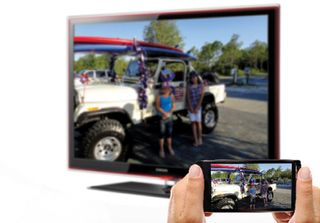DLNA Reality Check: From Phone to TV, How Well Does It Work?

Imagine that you walk into your living room, connect your smartphone to your home Wi-Fi network, and—before you can say “stream wirelessly!”—snapshots and music tracks from your handset’s library appear on your TV. This is not a dream. You can do this right now using gadgets that support DLNA, or Digital Living Network Alliance.
Through the DLNA initiative, product manufacturers and software companies allow Wi-Fi-capable devices to share music, photo, and video files across a wireless connection. Apple’s AirPlay technology is similar, but DLNA is found in many more gadgets—from Android phones and laptops to TVs and game consoles such as the PlayStation 3. So how well does DLNA work in the real world?
The Gear
To test the DLNA promise, we used two smartphones to stream music, photos, and video files to a 50-inch Samsung 50C7000 TV. The Samsung Epic 4G includes Samsung’s DLNA-enabled AllShare app for moving files over Wi-Fi. The Sprint HTC EVO 4G, our other test phone, has no native DLNA support, so we used a third-party app called Twonky Media Server to share files.
Update: DLNA recently added Wi-Fi Direct to its interoperability guidelines, giving enabled devices the ability to connect directly without a wireless router. Our tests were conducted using DLNA connections only.
Setup
Any DLNA device you would like to use—televisions included—must be connected to your home network. Since our TV didn’t have a wireless radio, we needed to connect the TV to our router via an Ethernet cable. We connected the Samsung 50C7000 to our router with ease, but others who keep their TVs and routers in separate rooms will need to explore alternative options to connect their sets (such as Powerline adapters).
Stay in the know with Laptop Mag
Get our in-depth reviews, helpful tips, great deals, and the biggest news stories delivered to your inbox.
AllShare is Samsung’s proprietary DLNA-based service, and it comes pre-installed on many Samsung products. Using this service, we connected the TV and the Samsung Epic 4G smartphone in seconds. The same went for the HTC EVO 4G using the Twonky Media Server app.
First, the smartphone applications prompted us to select one of three options for streaming media:
- Streaming files from the smartphone to the another device.
- Streaming media from a Wi-Fi-attached storage drive to the smartphone.
- Streaming files from another device to the smartphone.
Once we selected the first option—to send music, photo, and video files from our smartphone to the television set—the app prompted us to select a receiving device: the Samsung TV. After that, getting MP3 files from our favorite Weezer album, captured video from a concert, and photos from a summer vacation to display on the set was a matter of navigating AllShare or Twonky’s file management system.
Performance
Sounds like smooth sailing, right? Not entirely. First, DLNA only works with single media files, such as video clips captured using your phone’s camera or downloaded media files. Though DLNA can stream protected and commercial content, many service providers don’t yet support the technology (it’s likely that support will first roll out for set-top boxes and Blu-ray disc players connected to television sets or notebooks). So you can’t display video streamed through other applications, such as YouTube, on your television set. For now, users can’t stream protected content—such as Netflix—either.
Also, the one-file-at-a-time limitation means MP3 playlists must be queued up manually, and the DLNA connection takes a few seconds to access and stream each file. That brings us to another point: Streaming files with DLNA is slow. The 10- to 15-second delays we experienced between launching video files or new music playlists were a bit too long. Our music and video files never paused mid-stream, but we had some difficulty streaming certain audio and video files. For example, some DLNA software does not support GIF, PNG, or TIFF image files. We had trouble with the audio codec in a 3GP video file saved on the Epic 4G.
Another peeve? The interfaces in both the AllShare and Twonky services need work. The Twonky app at least groups music into artist and album subfolders, but AllShare displays audio files in one endless cascade, making it difficult to sift through our more than 1,200 music tracks to create playlists.
Verdict
Does DLNA work? Yes. Does it work perfectly? No. Sure, the technology allows you to stream photos and home videos captured on your smartphone and music files to your home theater. But that’s not the same as streaming premium movies and television episodes, which you can do with Apple’s AirPlay. Inconsistent interface design from device to device and performance lag also make DLNA less appealing than it should be.
